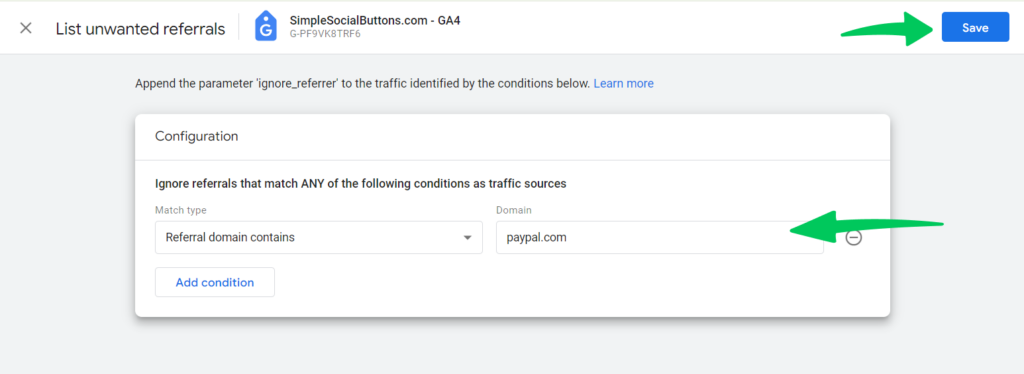
How to Implement GA4 Referral Exclusion (2025)
Are you interested in learning how to set up GA4 referral exclusion?
Navigating the e-commerce analytics can sometimes feel daunting, especially when you notice oddities in your traffic sources. Many of our WooCommerce or Easy Digital Downloads add-on users have raised concerns upon seeing payment gateway URLs like paypal.com overshadowing the real contributors to their traffic and sales. ‘
If you’re using PayPal to accept payments, you might find that Google Analytics 4 (GA4) attributes transactions to PayPal, missing out on the actual sources driving your e-commerce success. Whether those sources are your website, mobile apps, or specific product links, understanding and crediting them correctly is important for strategic growth.
In this article, we’ll explain the process of managing PayPal Google Analytics integration by setting up Google Analytics 4 referral exclusion for PayPal. By the end, you’ll have a clear roadmap on how to tweak your GA4 settings to prevent PayPal from hijacking your referral traffic, ensuring a clearer, more accurate view of your traffic sources and their contribution to your business’s growth.
GA4 Referral Exclusion (TOC):
What is GA4 Referral Exclusion?
Referral exclusion in Google Analytics 4 (GA4) is a feature that allows website owners to exclude specific domains from being counted as referral traffic. This is particularly useful for preventing your website’s domain or other trusted domains from being misidentified as external referral sources.
When a visitor moves between pages or domains that are part of your site or closely related sites, you don’t want those internal navigations to be counted as new referrals, right? Referral exclusions solve this issue.
Why does this matter?
Because accurately identifying where your conversions come from allows you to fine-tune your marketing efforts and invest more wisely. One effective strategy to ensure your analytics are on point is to leverage the GA4 referral exclusion feature by adding paypal.com to your referral exclusion list in GA4. This approach helps maintain the integrity of session tracking, ensuring that visits from PayPal don’t start new sessions and skew your data, giving credit where it’s due.
Why You Might Want to Use GA4 Referral Exclusion?
Referral exclusion in GA4 is not just a feature; it’s a strategy to ensure your data reflects true visitor behavior without the noise of internal or irrelevant referrals. Here’s why referral exclusion can be a game-changer for your analytics:
- Internal Traffic: Your own website should be a harmonious ecosystem, not a series of disjointed visits. By excluding traffic that navigates between your own domains, you ensure that your analytics capture genuine engagement without inflating your data with internal activity. This clarity helps you focus on genuine external referral sources that deserve attention.
- Third-party Services: Your website doesn’t operate in isolation. It interacts with payment gateways, marketing automation tools, and other third-party services integral to your operations. Traffic from these services, however, shouldn’t be mistaken for new referral traffic.
By setting up referral exclusions for these domains, you maintain the integrity of your referral data, ensuring it accurately represents external sources that direct visitors to your site. - Inaccurate Referrals: The digital world is complex, and sometimes referrals are not what they seem. Technical quirks, browser peculiarities, or misconfigurations can lead to referrals being incorrectly attributed. You can clean up your data by identifying and excluding these inaccurate referrals, ensuring your analytics are as precise and meaningful as possible.
How Google Analytics PayPal Referrals Happen?
Have you ever wondered why Google Analytics PayPal referrals show up in your reports, sometimes overshadowing the true sources that bring customers to your doorstep? It all starts when a customer decides to make a purchase
Here’s the typical journey: a customer adds products to their cart on your website and chooses PayPal as their payment method. This action redirects them to PayPal’s website to complete the transaction. Once the payment is successful, they’re brought back to your site to finalize the order.
Here’s where things get a bit tricky with Google Analytics 4 (GA4). The platform tends to mark PayPal as the referral source for that transaction, sidelining the actual origin—the website, ad, or link that initially led the customer to you. It occurs because GA4 is designed to identify the last webpage visited before the conversion as the referral source. While this method has its merits, it can create a significant disconnect in understanding your traffic’s true origins.
Such misattribution can cloud your analytics, leading to potential misinterpretations of your data. Recognizing the real contributors to your sales and traffic is crucial for optimizing your marketing strategies and investments. This is where the concept of GA4 referral exclusion becomes a game-changer.
By strategically adding PayPal to your referral exclusion list in GA4, you essentially tell Google Analytics to overlook PayPal as a referrer. This adjustment ensures that your analytics more accurately reflect customers’ paths to reach your site, focusing on the original referral sources rather than the payment gateway used during the transaction.
Managing Google Analytics PayPal referrals by excluding PayPal from your referral sources allows for a clearer, more accurate view of your customer journey. This clarity enables more informed decisions, helping you to better understand and leverage the channels that truly drive traffic and conversions to your site.
How to Implement GA4 Referral Exclusion for PayPal?
Excluding PayPal or other similar referral traffic in Google Analytics 4 (GA4) can significantly enhance the clarity of your visitor acquisition insights. This precise action allows you to see beyond the superficial data, focusing on the genuine sources driving traffic to your site.
Let’s learn a step-by-step guide on how to apply GA4 referral exclusion, specifically targeting Google Analytics PayPal referral exclusion, to ensure your analytics reflect your true referral sources accurately.
Step 1: Access Your GA4 Web Stream Settings
- Go to Admin >> GA4 Property Settings and select Data Streams.
Here, choose the web data stream you want to adjust for a more precise analytics setup.
Step 2: Configure Your Tag Settings for Referral Exclusion
- Within your chosen web stream, scroll to and click on Configure tag settings, This step is critical for accessing the settings necessary to implement a referral exclusion list GA4.
Step 3: Exclude PayPal as an Unwanted Referral
- Under the tag settings, you’ll find the section for List unwanted referrals. Here, you’ll define which referrals to exclude, specifically targeting PayPal, to ensure it’s not misrepresented in your analytics.
Step 4: Adding PayPal to Your Exclusion List
- It’s time to add PayPal to your exclusion list. You can also write any other referral which you want to exclude. You have a few options to customize this exclusion:
- Referral domain contains: The most straightforward option where you simply type paypal.com. This is the go-to method for a Google Analytics 4 referral exclusion.
- Hostname prefix: This choice is less common but useful if you need to exclude specific PayPal subdomains.
- Hostname suffix: An even less common option, not typically necessary for PayPal exclusions but available should you need it.
Step 5: Save Your Changes
- After setting paypal.com as your exclusion rule, make sure to Save your changes for the exclusion to take effect.
Important Considerations
- The GA4 referral exclusion might take up to 48 hours to fully integrate into your data.
- Excluding Paypal Google Analytics referrals affects only the source attribution, not other metrics like sessions or page views.
- While you’re at it, consider excluding other domains or sources that might skew your analytics for a more accurate overview.
- Exclusion is a powerful tool, but it should be used wisely. Over-exclusion can hide valuable insights.
Pro Tips
- Analyze the Impact: To gauge its effect, compare your referral reports before and after the exclusion.
- Use Segments: Create segments in GA4 to dissect traffic data with and without the PayPal Google Analytics exclusion.
- Beyond Exclusions: Consider custom dimensions or UTM parameters for nuanced tracking, especially for campaigns involving PayPal.
By following these steps and strategically applying GA4 referral exclusion, you can ensure your analytics more accurately reflect your true referral sources. This clarity allows for informed decisions, enhancing your site’s traffic acquisition strategy and optimizing your online marketing efforts.
GA4 Referral Exclusion FAQs
1. What is GA4 referral exclusion, and why is it important for PayPal transactions?
GA4 referral exclusion allows you to exclude specific referral sources, like PayPal, from being recognized as the referral source in your Google Analytics data. This is crucial for PayPal transactions because it ensures that the original source of the traffic—such as a search engine or social media link—is credited for the visit, rather than PayPal, where the visitor is redirected to complete their purchase. This gives you a more accurate understanding of where your traffic is coming from.
2. How can I add PayPal to my referral exclusion list GA4?
To add PayPal to your referral exclusion list GA4, navigate to your GA4 Property Settings, select Data Streams, and choose your web data stream. Click on Configure tag settings, show all settings, and find the List unwanted referrals section. Here, you can add “paypal.com” to exclude it as a referral source.
3. How long does it take for a Google Analytics 4 referral exclusion to take effect?
A Google Analytics 4 referral exclusion typically takes up to 24-48 hours to fully take effect. Monitoring your referral data before and after making this change is important to ensure the exclusion is working as intended.
4. Will excluding Google Analytics PayPal referral traffic affect my other metrics?
Excluding Google Analytics PayPal referral traffic will not impact other metrics such as sessions, page views, or user engagement data. It only affects how the referral source is attributed, ensuring that PayPal is not mistakenly credited as the source of traffic that leads to conversions.
5. Can I exclude other payment gateways besides PayPal Google Analytics?
Yes, you can exclude other payment gateways besides PayPal Google Analytics by adding them to your referral exclusion list in GA4. This is useful if you use multiple payment processors and wish to maintain accurate tracking of your original traffic sources.
6. What are some common issues to look out for when setting up GA4 referral exclusion for PayPal?
When setting up GA4 referral exclusion for PayPal, ensure that you correctly type the domain name (“paypal.com”) to avoid errors. Use this feature carefully and consider excluding only those domains that genuinely skew your referral data.
7. How can I verify that my PayPal Google Analytics referral exclusion is working?
To verify that your PayPal Google Analytics referral exclusion is working, compare your referral traffic reports before and after applying the exclusion. Look for a decrease in traffic attributed to PayPal as a referral source and an increase in the original referral sources. It’ll indicate that the exclusion is correctly attributing traffic to its initial source.
Conclusion
Accurately tracking your website traffic and business insights is essential for making informed decisions that drive your business forward. By effectively using the referral exclusion list GA4, businesses can ensure that their Google Analytics 4 data accurately reflects their true traffic sources, offering clearer insights into visitor acquisition strategies.
We’ve explored how Google Analytics PayPal referral traffic occurs, often misattributing the source of a transaction to PayPal when, in fact, the visitor originated from another site. This misattribution can skew data and disturb the real performance of marketing campaigns. To resolve this, we provided a step-by-step guide on applying Google Analytics 4 referral exclusion for PayPal, ensuring that your analytics accurately track the customer journey from initial engagement to conversion.
Remember, while excluding PayPal from your referral list, patience is key, as changes can take up to 48 hours to apply fully. Moreover, this exclusion is targeted; it does not affect other metrics, such as sessions or page views, but refines the attribution of your referral sources. By carefully managing your GA4 referral exclusion, you can better understand your traffic sources, empowering you to make more strategic decisions in your marketing efforts.
By following the outlined steps to manage referral exclusion in GA4, you can ensure that your analytics has a true picture of where your traffic comes from, allowing you to focus on strategies that drive your business forward.








